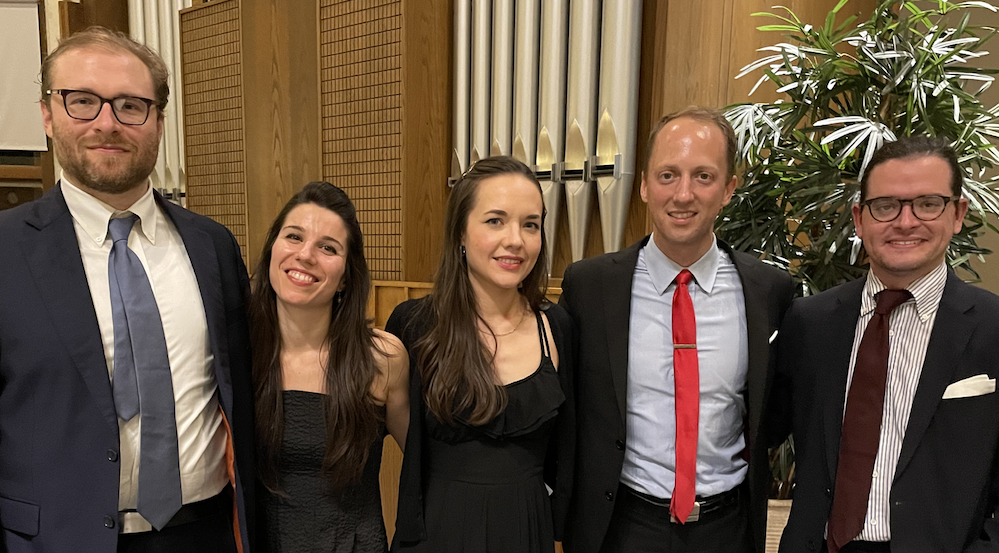|
Symphony
FROM THE NEW WORLD TO THE OLD WORLD
by Peter Lert
Saturday, June 14, 2025
Chamber
MC2 DUO RECITAL CLOSES 222'S SEASON
by Terry McNeill
Saturday, June 14, 2025
Choral and Vocal
CANTIAMO SONOMA'S LUSCIOUS A CAPELLA SINGING IN SEASON ENDING CONCERT
by Pamela Hicks Gailey
Sunday, June 8, 2025
Symphony
SRS SEASON ENDS WITH RESOUNDING TA-TA-TA-BANG
by Terry McNeill
Sunday, June 1, 2025
Symphony
YOUTHFUL VIRTUOSITY ON DISPLAY AT USO'S MAY CONCERTS
by Peter Lert
Saturday, May 17, 2025
Symphony
MYSTICAL PLANETS AND LIVELY GERSHWIN ORTIZ AT FINAL SRS CONCERT
by Peter Lert
Sunday, May 4, 2025
Symphony
VSO'S CONCERT MUSIC OF TIME, MUSIC OF PLACE
by Peter Lert
Sunday, April 27, 2025
VOCAL ELEGANCE AND FIRE AT THE 222'S RECITAL APRIL 26
by Pamela Hicks Gailey
Saturday, April 26, 2025
CANTIAMO SONOMA SINGS AN INSPIRED GOOD FRIDAY MOZART REQUIEM CONCERT
by Pamela Hicks Gailey
Friday, April 18, 2025
DRAMATIC SHOSTAKOVICH SYMPHONY CLOSES PHILHARMONIC'S 25TH SEASON
by Terry McNeill
Sunday, April 13, 2025
|
 |
 Manhattan Chamber Players |
THRILLING PIANO QUINTETS IN MILL VALLEY CHAMBER CONCERT
by Abby Wasserman
Sunday, November 14, 2021
The Mill Valley Chamber Music Society sprang back to life on November 14 when a stellar ensemble from the Manhattan Chamber Players, a New York-based collective, arrived to perform two piano quintets: Vaughn-Williams’ in C Minor (1903), little known and rarely performed; and Schubert’s in A Major D. 667 (the “Trout,” 1819) one of the most frequently performed works in the chamber repertoire.
This is the 49th season of the Society, and after the enforced hiatus due to the pandemic, outgoing president Bill Horne and incoming president Jane Rogers took the stage in front of the capacity Mt. Tamalpais Church audience to be honored.
Violist Luke Fleming, the Players’ founder, introduced the Vaughn-Williams, and the rest of the quintet then settled in for the lush and dramatic first movement (Allegro con fuoco) with slicing, roiling cascades of sound that evolved sweetly into a chorale underscored by double bass pizzicato. In this quintet, as with the Schubert and very few other piano quintets, the double bass replaces the second violin, creating a subtle earthy grounding to the harmonies.
Pianist Adam Golka elicited rich instrumental sonorities with thrilling runs and ringing arpeggios, and the strings’ sounds rose, blended and fell back, their individuality clearly audible. The musicians played with admirable ensemble clarity and with balance. Mr. Fleming’s viola line combined with the double bass (Nicholas Cathcart), and Andrea Casarrubios’ elegant cello playing and Emily Daggett Smith’s soaring violin added lyrical flights and ominous undercurrents to this passionate, poetical work. The first movement ended on a hushed unison note, a reverent stillness, out of which the tender Andante movement emerged with chorale-like sequences, the strings at times sounding a benediction.
The Fantasia third movement blossomed with motifs and echoes from the strings and piano, then a transparent canon that grew in complexity, with staccato passages and insistent repeated notes morphing into elegant legato, and a sudden turbulence with percussive chords restlessly ascending and falling until, with a palpable weariness, the music hesitated and slowed. Then, toward the conclusion of the work, the pace quickened and slowed, like a storm that breaks and then passes over. The quintet ended tranquilly and the audience responded with enthusiasm, many standing to applaud.
Schubert composed the beloved “Trout” when he was only 22, but it was not performed publicly until after his death at 32; the reason for this delay is not known. But like Hummel before him and Vaughn-Williams after him, he substituted the double bass for second violin. Mr. Fleming introduced the quintet as “one of the brilliant pillars of chamber repertoire,” and in a charming and unexpected treat, Ms. Smith and Mr. Golka joined together to play the Schubert song on which it is based - The Trout (Die Forelle), taking us right to the source.
Die Forelle is the basis for the quintet’s theme and its fourth movement variations. It tells the story of a fisherman hooking a lively trout and an onlooker’s distress at seeing the struggling fish, but is also thought be a warning to girls to watch out for young men who would “catch” them. The evocation in the music is of a shining stream with the flashing silver scales of a fighting fish and the sadness that something so beautiful must lose its life.
There are five movements. The first, Allegro vivace, in sonata form, was performed alternately gaily and introspectively; the following Andante, as a lullaby with dark, lovely harmonies from the strings. When the piano line jumped into the midst of those harmonies, it was like a fish leaping out of a cascading stream. The third movement, in three-quarter time (Scherzo: Presto), is also full of brave leaps and lunges, the vigor of life asserting itself, undercut by a plaintive melody from the double bass. The fourth movement, the six variations on Schubert’s song, Andantino, showed off each musician’s skill in various combinations, and all shone forth in turn. Only once, in a particularly exciting passage on the piano, did Mr. Golka briefly drown out the strings, and there it might have been to express the fisherman’s triumph.
The Allegro Giusto final movement brought the quintet to a buoyant pitch, creating a peasant dance effect with trade-offs by strings and piano and a thrilling rhythmic pulse. This so-familiar work had been given fresh and vivid life, and the appreciative audience rose as one, giving the musicians a standing ovation. No encore was offered, but none was necessary, and many in the audience said they were ecstatic to be back with live music.
|

